Buddhistdoor Global 2016-12-16
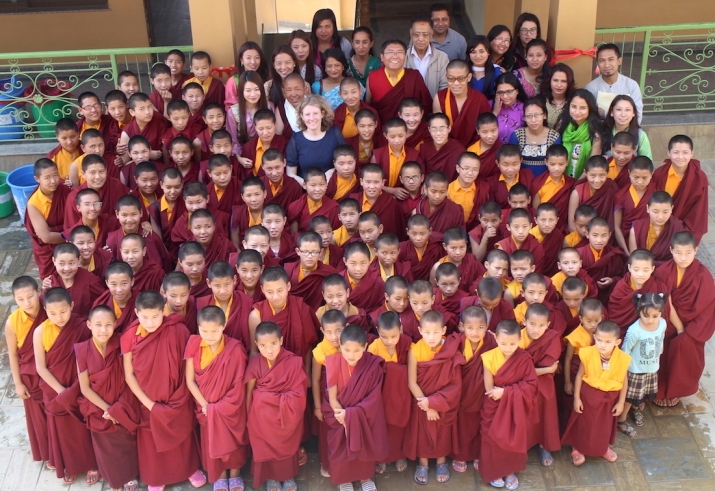 Grade 1–5 registration and Rato Bangala Foundation graduation celebration. Image courtesy of Tsoknyi Gechak School
Grade 1–5 registration and Rato Bangala Foundation graduation celebration. Image courtesy of Tsoknyi Gechak School
It is impossible to overstate the profound difference that Tsoknyi Rinpoche has made in the lives of the young nuns of Tsoknyi Gechak Ling, a nunnery on a hilltop outside Kathmandu. Many of them are attending or have graduated from the primary and lower secondary school of Tsoknyi Gechak School, which combines all the elements of a modern international curriculum to enrich the traditional Himalayan monastic studies. Before they enter the school, the girls (who are from poor subsistence farming households) are overwhelmingly shy and quiet. Tsoknyi Rinpoche feels extremely proud that after only a few years of nurture, they become unafraid of rising to challenges and are able to communicate confidently with outsiders.
“When I first came into contact with the outside world, myself, I had no understanding of science, psychology, or social education—so many things were lacking and it was hard to communicate. I call this a ‘healthy wound.’ I understood that if you did one thing while missing something else, it wouldn’t be complete,” Rinpoche told me during a recent visit to Hong Kong.
Before the school day begins, the nuns complete a morning memorization class, eat breakfast, and perform morning prayers. Classes run from 9am–3pm, during which the nuns are immersed in a modern secular education. Afterwards, they engage in more traditional training, such as learning to play ritual musical instruments, making torma (ritual figures made from flour and butter), and calligraphy.
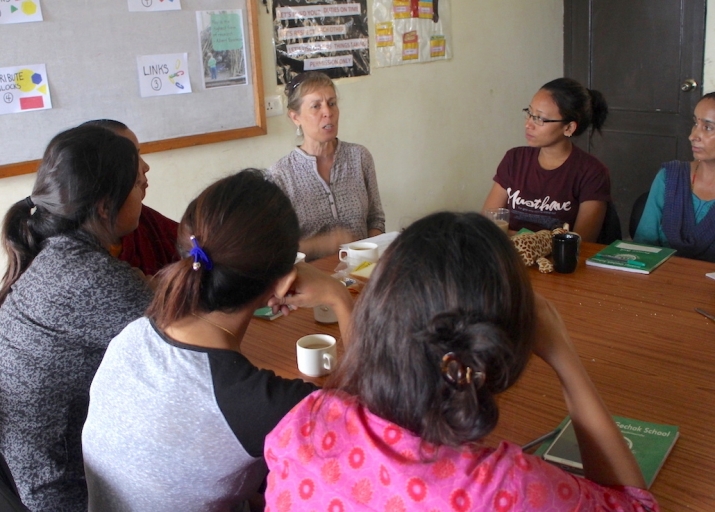 Volunteer Kathryn O'Connor leads an after-school workshop. Image courtesy of Tsoknyi Gechak School
Volunteer Kathryn O'Connor leads an after-school workshop. Image courtesy of Tsoknyi Gechak School
To find out a little more about life at the school, I spoke separately with the director of Tsoknyi Gechak School, Fionnuala Shepen, who has helped to provide the school’s methodological foundations. “The school follows the Nepal government curriculum. We teach Tibetan, English, Nepali, science, physical education, social studies, and art. We have six class periods, one for each subject. To guarantee our students a high quality educational experience, all our staff have been trained in modern teaching methods,” she said. “Initially we collaborated with the Rato Bangala Foundation (RBF), a primary teacher-training foundation here in Nepal that draws on the progressive educational style of the Bank Street School in New York.” The Bank Street School stresses empathetic and emotional development in an open and long-term learning environment.
“Over two years, RBF trainers delivered a comprehensive training program to all our teachers, including classroom observation and feedback sessions. We now run our own in-house training, lead by teachers who have completed RBF's full-time Primary Teacher Training Program. We receive additional support for the kindergarten section from our volunteer Kathryn O'Connor, who also trained in the Bank Street method.”
Rinpoche underscored his lineage's tradition of supporting female monastics. “The first Tsoknyi Rinpoche, Drubwang Tsoknyi Rinpoche (1849–1904), pushed to empower Buddhist education for nuns. It was he who asked his disciple, Tsang-Yang Gyamtso, to build the first nunnery in eastern Tibet, Tsoknyi Gechak Ling,” he said. “As the third Tsoknyi, I want the nuns to have a well-rounded education. The previous style of teaching was focused on practice and meditation, but I am bringing in the scholarly degrees of Geshe and Khenpo,* and modern education, bringing together these three aspects to transform the nuns so that they are capable of interacting with the outside world.”
Rinpoche hopes the nuns will be sufficiently advanced to participate in the traditional three-year retreat for monastics and receive higher education at the shedra (monastic college) in the temple complex. However, he is very clear about what young women really need to survive and thrive. “What if some girls, with only a traditional Buddhist education, decide to leave their nunnery? They’re already 19 or 20. They cannot survive on a monastic education because they don’t have any practical skills. So they have to stay in their village, they have early marriages. . . . They will have no life; they have to start from zero. Such a waste.”
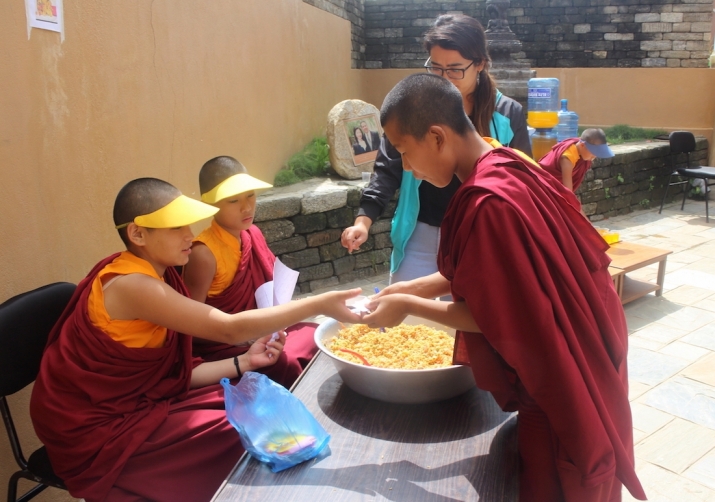 Class 2 runs a mini market for a school project. Image courtesy of Tsoknyi Gechak School
Class 2 runs a mini market for a school project. Image courtesy of Tsoknyi Gechak School
An education at Tsoknyi Gechak School equips the girls with a comprehensive education, regardless of the path they ultimately choose: “I hope that 80 per cent of the nuns stay in the nunnery,” stressed Rinpoche pragmatically. “But if they leave, I will have peace of mind because they have qualifications to live a secular life.”
To bring international standards of teaching to a Nepalese Buddhist environment, Rinpoche needed someone with experience in Western-style education. Fionnuala was born in Ireland and met Tsoknyi Rinpoche in 1999, after which she lived and worked in Kathmandu for six years. “During that time I was involved with an education project and also lived at Osel Ling Gompa, which was Tsoknyi Rinpoche’s and Mingyur Rinpoche's gompa at that time (now it is solely under Mingyur Rinpoche). I spent a couple of years learning Tibetan and helping the gompa manager to run the gompa,” Fionnuala told me. “In 2006 I moved back to Europe, and in 2012 Tsoknyi Rinpoche asked me to come to Nepal to help with his project. So, in January 2013, I returned to Nepal and started work on Tsoknyi Gechak School.”
Starting a school in a developing country for a marginalized minority community was immensely challenging. “I thought Rinpoche's vision of a modern school in a gompa was just way too ambitious, but I am happy to learn that I was wrong,” said Fionnuala. “It has been incredibly hard work to get to where we are. Just consider the low teaching standards and general lack of resources in most Nepali schools. Add to that the serious language barriers, as three languages (Tibetan, Nepali, and English) are actively used in the gompa and most of us only know two! However, it is very rewarding and satisfying to stand back and see colorful, learning-rich classrooms staffed by teachers with skill and confidence, and actively engaged students.
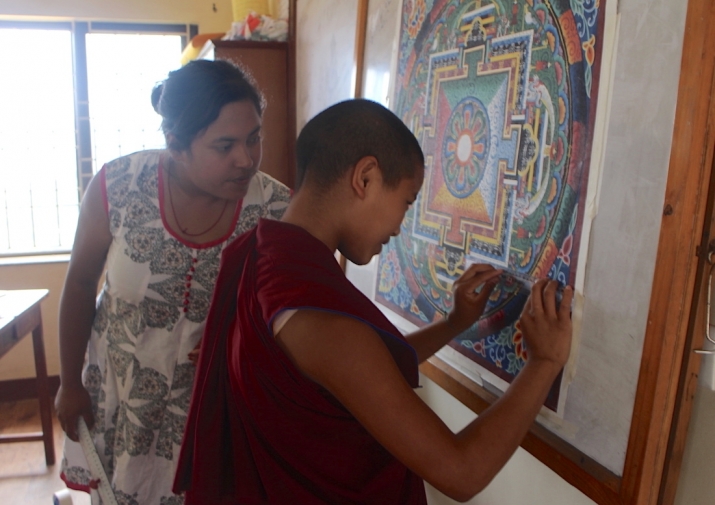 Measuring a mandala for maths class. Image courtesy of Tsoknyi Gechak School
Measuring a mandala for maths class. Image courtesy of Tsoknyi Gechak School
“Each year during the second term we focus on project work. The teachers choose an age-appropriate project and, over a series of classes, engage the children in choosing and planning a topic,” Fionnuala explained. “Projects often include field trips to gather information. Junior students enjoy visiting the Bodhi tree just outside the school gate to gather leaves for maths activities, or drawing and painting. Class 2 students pay a visit to a local supermarket to learn about the marketplace, products, and buying and selling. Afterward, they create their own mini market at school, selling snacks to their schoolmates. The project combines maths, cooking skills, and learning about the services in their local community, as well as budgeting and managing money.”
Learning is not restricted to the classroom. “In the higher grades, students choose a suitable field trip on which to gather information, such as a trip to a museum in Kathmandu, and invite experts to talk about a topic,” said Fionnuala. “For each field trip, the students create a trip book detailing where they went, what they learned, and how they felt about the experience as a whole. As part of their project work, they create models, charts, and displays to illustrate what they learned and how. They also create interactive games based on their topic, which serve as learning materials for their classrooms.”
The fruits of the nuns’ studies are displayed at an annual school exhibition. It is a day to welcome the public, including the students’ families, friends, and supporters, and schoolchildren from neighboring schools and other monastic schools. The chief guest is Tsoknyi Rinpoche himself, who enjoys the company of the students and keenly examines each project. “Though shy at first, the nuns delight in being able to show Rinpoche all that they have learned that year,” said Fionnuala.
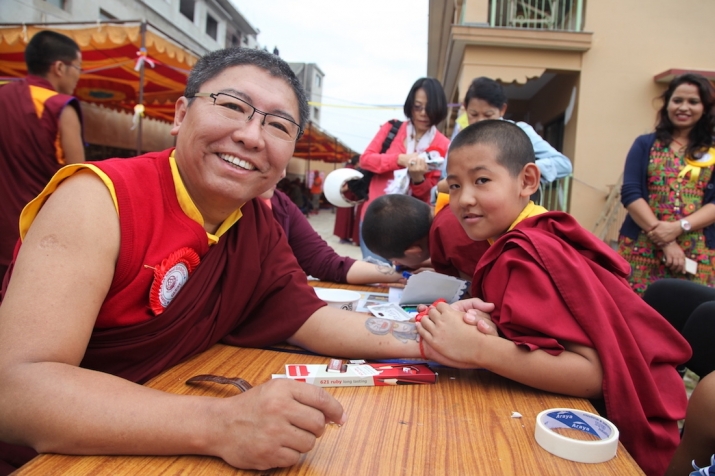 Rinpoche visits Class 3's body-painting stall at a school expo. Image courtesy of Tsoknyi Gechak School
Rinpoche visits Class 3's body-painting stall at a school expo. Image courtesy of Tsoknyi Gechak School
Tsoknyi Rinpoche is unambiguous. “I want to change the culture,” he said about Nepal. “Hopefully in a good way . . . for our new times. Timely Dharma. If we can produce an enlightened bodhisattva that would be the best, but they are very rare. The majority have to cope with modern life and if we don’t have a healthy education system, I don’t believe an extraordinary being can emerge.”
* Feminine: Geshema and Khenmo.
No comments:
Post a Comment